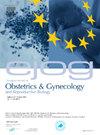Effect of epidural labour analgesia on gastric emptying during labour: A prospective controlled study
IF 2.1
4区 医学
Q2 OBSTETRICS & GYNECOLOGY
European journal of obstetrics, gynecology, and reproductive biology
Pub Date : 2025-03-07
DOI:10.1016/j.ejogrb.2025.03.003
引用次数: 0
Abstract
Background
Epidural analgesia is frequently used to alleviate labour pain, and dietary management during labour is of crucial importance. Therefore, this study investigates the impact of epidural analgesia for labour on gastric emptying in parturient women.
Methods
A total of 70 full-term parturient women were recruited and divided into two groups: the epidural analgesia group (LA, n = 35) and the non-epidural analgesia group (NA, n = 35). Fasting gastric antrum cross-sectional area (CSA0) was assessed using B-mode ultrasonography at T0. Both groups then consumed 300 g of millet porridge (600KJ). Post-meal, CSAs were measured at 60 min (CSA1, T1), 90 min (CSA2, T2), and 120 min (CSA3, T3) using ultrasonography. Pain scores were recorded for both groups at these four time points, and gastric emptying time was noted.
Results
The CSA in the NA group were larger than those in the LA group (CAS1:11.4 ± 0.8 vs 10.2 ± 0.6;CAS2:9.3 ± 0.6 vs 8.3 ± 0.5,CAS3:7.4 ± 0.5 vs 6.5 ± 0.4; P = 0.00). The gastric emptying time in the LA group was shorter than that in the NA group (197.5 ± 27.2 vs. 220.9 ± 29.2, P = 0.00).
Conclusions
Epidural analgesia facilitates gastric emptying during labour. Therefore, the administration of epidural analgesia during labour does not adversely affect maternal dietary preferences.
Plain language summary.
During labour, women often endure severe pain, prompting the widespread use of epidural analgesia for pain relief. However, the dietary considerations for women opting for epidural analgesia during labour have increasingly garnered attention. Numerous studies have now corroborated that moderate food consumption can supply energy to women without posing any detrimental effects. Our research has observed that epidural analgesia can expedite gastric emptying during labour. Previous clinical experience suggested that patients should not eat before or after anesthesia, but this study shows that even if a parturient opts for epidural labor analgesia, she can still continue to consume a certain amount of semi-solid food to provide energy throughout the labor process, without needing to worry about an increased risk of vomiting.
求助全文
约1分钟内获得全文
求助全文
来源期刊
CiteScore
4.60
自引率
3.80%
发文量
898
审稿时长
8.3 weeks
期刊介绍:
The European Journal of Obstetrics & Gynecology and Reproductive Biology is the leading general clinical journal covering the continent. It publishes peer reviewed original research articles, as well as a wide range of news, book reviews, biographical, historical and educational articles and a lively correspondence section. Fields covered include obstetrics, prenatal diagnosis, maternal-fetal medicine, perinatology, general gynecology, gynecologic oncology, uro-gynecology, reproductive medicine, infertility, reproductive endocrinology, sexual medicine and reproductive ethics. The European Journal of Obstetrics & Gynecology and Reproductive Biology provides a forum for scientific and clinical professional communication in obstetrics and gynecology throughout Europe and the world.

 求助内容:
求助内容: 应助结果提醒方式:
应助结果提醒方式:


